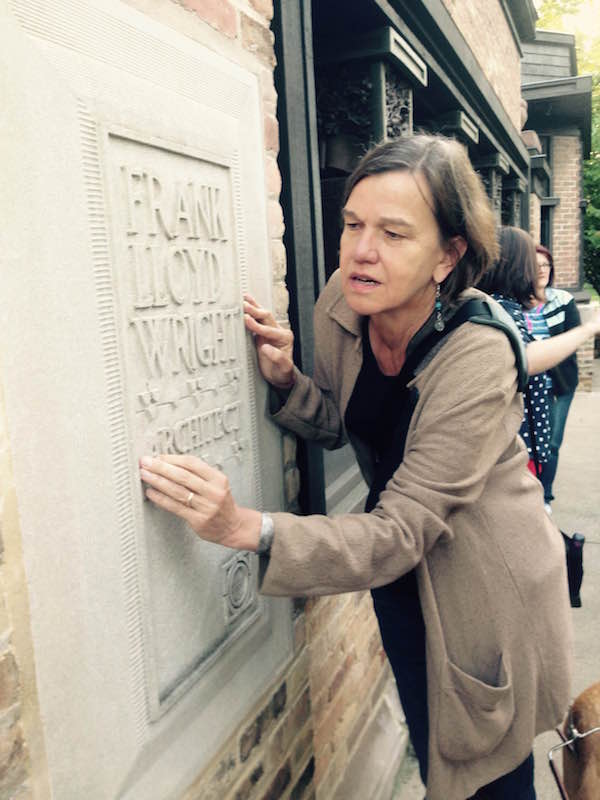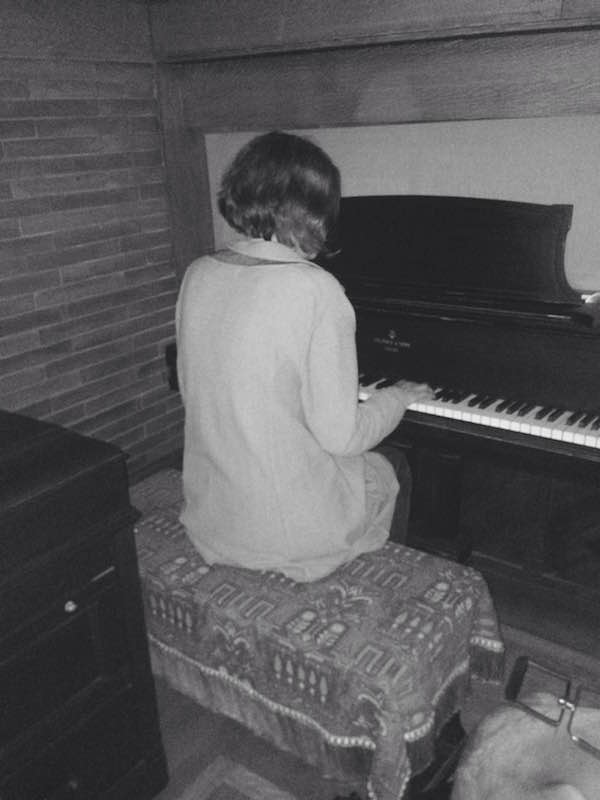Remember that post I wrote about the Frank Lloyd Wright Trust offering touch tours of its historic sites this year? My friend Linda Downing Miller lives in Oak park, Ill., and last Saturday she accompanied me on a special tour of Frank Lloyd Wright’s Home and Studio there .
Linda earned an MFA from Queens University of Charlotte — her fiction is forthcoming in Fiction International and appears in the current issue of Crab Orchard Review. She’s a fine writer, and I was delighted when she offered to write this guest post describing our tour from her point of, ahem, view.
by Linda Downing Miller
Twenty years ago, I was infatuated with the architect Frank Lloyd Wright. Moving to Oak Park, Ill., can do that to you.
The village has a wealth of Wright-designed spaces, and I toured as many as I could in my first years here. My husband and I must have taken every visitor we had through Wright’s Home and Studio, restored to its appearance when he last lived there in 1909.
When Beth invited me to go with her on a Touch Tour of the Home and Studio last Saturday, I said yes mostly for the chance to spend time with her. I figured I’d already seen and heard enough about Wright’s work: his horizontal lines and ribbon windows and half-hidden entrances, reached by walking a “path of discovery” that usually includes a turn or two.
The Touch Tour took me on a new path. I was one of a handful of people accompanying friends or family members who are blind or have low vision. The Frank Lloyd Wright Trust offered the tour in honor of the 25th anniversary of the Americans with Disabilities Act, part of ADA 25 Chicago — a larger project to improve the quality of life for people with disabilities. Being Beth’s companion on the tour, alongside her Seeing Eye dog, Whitney, allowed me to “re-see” Wright’s spaces and consider the challenge of making them accessible through other senses.
Fellow writers might appreciate this observation: details, creative comparisons, and specific word choices helped to convey Wright’s work. Our tour guide, Laura Dodd, explained the position of design elements in relation to bodies (“about neck high”). She used similes (wood beams arranged “like an asterisk”). I told Beth that Wright’s intricate, wood-carved designs on the dining room and playroom ceilings were a bit like the wooden trivets she’d felt in the gift shop. A tour volunteer described the vaulted ceiling in the children’s playroom “like a whiskey barrel.”
After thinking about Laura’s description of the way the Wrights’ piano sat in that room with only the keyboard showing, the back half hidden behind the wall, one of the visitors who couldn’t see articulated it more clearly for all of us: “You mean, it’s embedded in the wall.” Yes.
Enthusiasm, curiosity, puzzlement and understanding moved across people’s faces as they listened and asked questions, and as they touched things: fireplace tiles, wall coverings, sculptures, spindles, glass windows and Wright’s famously uncomfortable straight-backed dining chairs. Some people lingered over each touch opportunity. Others eagerly applied their fingers and moved on. (Guess which style was Beth’s?)
She and I talked afterward about the different frames of reference people might have brought to the experience. Beth knew something about architecture before she lost her sight. Other visitors may have been born blind. Laura is the Director of Operations and Guest Experience for the Frank Lloyd Wright Trust, and she asked us for feedback during and after the tour. (The Trust plans additional Touch Tours, and American Sign Language Tours, at its historic sites.)
Our group’s consensus was that she’d done a wonderful job. I thought the three guide dogs in the group also handled themselves well in close proximity.
One of the highlights for me and Beth was when Laura invited her to sit at the piano in the children’s playroom. After instructing everyone else not to pay attention, Beth put her fingers on the keys and ran through a short, jazzy tune. When she’d finished, she and I exclaimed over the fact that Frank himself no doubt played those keys. I felt the ghost of my old infatuation. On our way downstairs, Beth reached up to touch the back end of the piano, suspended over our heads, and continued on her path of discovery.
Photos courtesy of Christena Gunther, Founder & Co-Chair of the Chicago Cultural Accessibility Consortium.


Wonderful. I loved Linda’s words, “…accessible through other senses.” Transforming light, color and space into touch oriented pleasures is like converting prose into poetry. Sounds like you both had a great time.
We did! I, too, very much appreciated Linda’s writing here. You’re absolutely right: prose into poetry.
_____
Great piece, Linda!
Love all the description. Got me thinking about how I currently use description in writing .
I would normally guess that Beth felt and quickly moved on, but I have a feeling she lingered here.
-Cam
Thanks Cam. And your first instinct was right about Beth’s style here: interested and efficient. That’s one reason when she offers up a chance to get together, I tend to grab it!
A total pleasure to the senses: the ‘not-so-visua’, the visual…..and the language! I am ready to visit Frank Loyd Write again. thank you Linda and Beth, A
All thanks to Linda –she met Whitney and me at the Oak Park train stop and got us to the FLW home and studio, she drove us home afterwards and then, she wrote this, ahem, touching guest blog post.
_____
I am curious about the effectiveness of similes for those who were born blind. Any ideas?
You know, I kind of wondered about the asterisk simile — people born blind would probably only know it as a symbol you use to refer to a footnote. The barrel simile would work, I think, because many adults have run across a barrel in their lives or have read books with barrels mentioned in them (and in the best of worlds, an itinerant vision teacher at school would know to call out that barrel reference and work with the the child who is blind to explain it. Am hoping some of our blog readers who were born blind or lost their sight very early in life might chime in on this one — if it’s okay with you, I may forward your question to two of them — blindbeader https://blindbeader.wordpress.com/ and Sandy’s View https://sandysview1.wordpress.com/
_____
This subject really never crossed my mind! But then again, I was fortunate enough to grow up with family and teachers that made sure to describe/explain as much as possible to me. I read Braille, so I definitely know what the asterisk Braille symbol *looks* like, and people have described the print asterisk as a star. I do know that at one point or another I felt a barrel as a child, so I can definitely associate with that.
This is definitely a topic that should be covered more — thanks for the idea and for sharing my blog!!
love this! brings back shades of my childhood home..designed by a student of FLW. and memories of that spring day I shared with Linda and friends back in 1990 at the glorious Unity Temple in Oak Park
Leave a Response